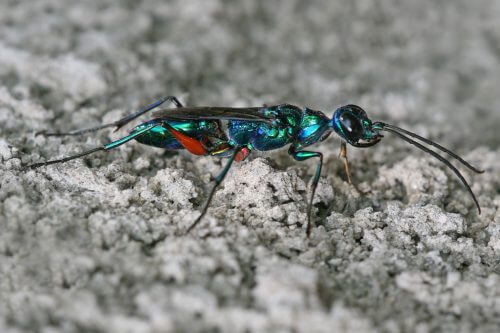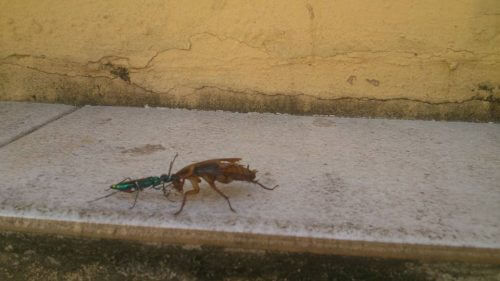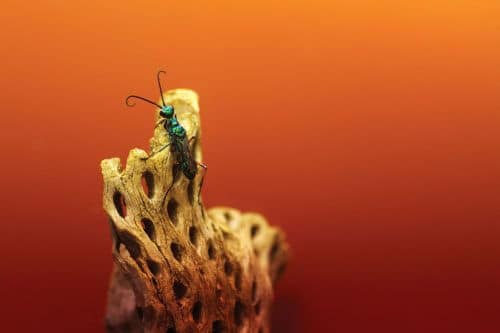A mixture of chemicals injected into the brains of cockroaches turns them into servants in the hands of a tiny wasp, and into a fresh and perfect meal for her offspring

- A spectacular wasp depends for its existence on live cockroaches that serve as a necessary food source for its offspring after they hatch from the eggs.
- The wasp forces cockroaches into a state of submission and obscurity, using a unique chemical mixture that it developed during evolution; She injects it into the cockroaches' brains and causes changes in their behavior and metabolism.
- Many other species of wasp also use complex types of venom and use it to paralyze spiders, caterpillars and even larvae of other wasps, sometimes turning them into zombie protectors of their offspring.
I don't know if cockroaches dream, but if they are capable of dreaming, I think that wasps of a certain species, which look like jewels studded with shining gems, play a major role in their nightmares. We humans have nothing to worry about, because these little tropical wasps, living in solitude, do not manipulate our minds so that we do not resist when they serve us, while we are alive, as a meal for their offspring, as they do to the innocent cockroaches. This is the stuff horror movies are made of, literally: the jewelry leprosy, Ampolex Compressa, and similar species from its family are the source of inspiration for the terrifying sights of the alien breaking out of the victim's chest in the Eighth Passenger films and their accompanying products. The story is simple, even if it seems far-fetched: the female wasp takes over the brains of cockroaches and uses them as food for her offspring. It eliminates their sense of fear or the urge to escape. But unlike what we see on the screen, this is not some virus for which there is no cure, turning a healthy cockroach into a mindless zombie. It is the wasp venom that does this. And it's not just poison, but a unique poison that works like a poison that hits the cockroach's brain.
Brains are nothing but clumps of nerve cells, and one is whether we are talking about the brains of humans or insects. There are millions of different types of venom in nature that can activate or paralyze nerve cells. It is therefore no wonder that there are also several types of venom capable of damaging the central nervous system, including our brain, which is usually well protected. There are those who jump over physiological barriers in their passage from remote points of insertion into the body, through the blood-brain barrier, and enter the brain of the victims. Others are injected directly into the brain, as the jewel leprosy does to its host cockroach.
How do you make a zombie?
The jewel wasps provide a beautiful example even if they drop terror, poisonous venom, which affects the nervous system and is capable of causing it much more severe damage than normal paralysis. This wasp, whose body is much smaller than that of its victim, begins its attack from above. She pounces on the cockroach in flight, clutching it in her jaws and in the process directs her stinger, an organ developed in wasps from the egg-laying tube, to a certain point on the cockroach's chest, located between its two front legs. The quick stab lasts a few seconds. The compounds found in the venom work very quickly and cause temporary paralysis of the cockroach. In this state the wasp directs its next sting with greater precision. She directs her long stinger to two areas in the cockroach's head ganglia, the insect equivalent of the brain, and injects them with the venom that changes their function.
The wasp's sting is adapted to the victim to such an extent that it is able to sense with great precision its position under the hard shell of the cockroach's head and inject the venom directly into certain parts of the brain. The stinger senses its location in the cockroach's head while relying on mechanical and chemical signals that help it pass the sheath that surrounds the ganglia (the cockroach's equivalent of the blood-brain barrier). After passing the barrier, he injects the venom exactly at the point it is supposed to reach. The two areas of the cockroach's brain that the wasp focuses on are very important to her; The researchers removed them from the brains of cockroaches to see how the wasp would react, and found that after these areas were removed, the wasp tries to find them and spends a lot of time searching with its stinger stuck in the cockroach's body, trying to locate the missing brain areas.

Now begins the takeover of the mind. In the first stage, the cockroach performs, for the most part, self-care movements (such as cleaning tentacles); As soon as the cockroach's front legs are freed from the temporary paralysis caused by the first venom injection, it begins to treat and clean itself thoroughly for about half an hour. Scientists have shown that this behavior is unique to the effect of the venom, since various harassments such as stabbing the cockroach in the head, harassing it in general or contact with a wasp without stinging did not arouse the same hygienic urge in it. This sudden need to clean also arises if the cockroach's brain is flooded with dopamine, so we believe that a dopamine-like compound found in the venom may be the cause of this behavior. The question of whether the self-cleaning is a sign of a beneficial effect of the venom or just a side effect is still controversial. Some believe that this behavior guarantees food free of bacteria and fungi for the wasp's vulnerable offspring; Others think it's a diversion that allows the wasp to prepare to repair its grave.
Dopamine is one of the intriguing chemicals found in the brains of animals from a huge variety of biological species, from insects to humans, and its effects are crucial in the bodies of all these species. In our brain, dopamine is part of the reward system; Dopamine surges occur in response to pleasant situations. Since it makes us feel good, dopamine can be wonderful, but it is also associated with addictive behaviors, and the "high" feeling that arises under the influence of drugs such as cocaine. We have no way of knowing if a cockroach can also feel a euphoria-like sensation when its brain is flooded with dopamine, but I prefer to think that this is what happens to it. (Because if not, the story seems too cruel to me.)
While the cockroach cleans itself, the wasp abandons its victim and goes to look for a comfortable place. It needs a dark burrow where it can leave its offspring and its food, in the form of the zombie cockroach, and it takes some time to find and prepare the right place. When she returns about thirty minutes later, the effects of the venom have already seeped in and the cockroach has completely lost the urge to escape. Basically, this condition is temporary and reversible. If you separate a poisoned cockroach from its would-be killer, that is, before the wasp laid the egg and before the larva (larva) emerged from it, the effect of the poison passes a week later. Unfortunately for the cockroach, this period of time is too long. Before its brain can return to its normal state, the offspring has already fed and eliminated its host.
The cockroach's motor skills are not impaired, but the insect shows no need to use them. The venom does not dull the insect's senses, but only changes the way its brain responds to them. Researchers found that stimuli that normally trigger avoidance responses such as touching the cockroach's wings or legs continue to send nerve signals to the cockroach's brain, but they do not trigger any behavioral response. This is because the venom silences certain nerve cells and dulls their responsiveness and activity, thus making the cockroach fearless and seemingly ready to be buried and eaten while alive. This activity of the venom requires the involvement of toxins that harm theGABA-dependent chloride channels.
GABA, or in its full name: Gamma aminobutyric acid, is one of the neurotransmitters (neurotransmitters) most important in the brains of insects and humans. If we imagine the activity of nerve cells to a party, GABA is the ultimate joy breaker. It blunts the excitability of a nerve cell by activating chloride channels. When chloride channels open, they allow chloride ions to flow through them. Since the negative chloride ions are attracted to positive ions, if it happens that chloride channels open at the same time as sodium ion channels open, the chloride ions can cross the cell membrane at almost the same rate as positive sodium ions and they make it difficult for the sodium ions to start the chain of events of the transmission of the nerve signal. Thus, even though the nerve cell receives an "act" command, the action potential is stopped before it develops. However, GABA is not a complete inhibitor - the chloride channels cannot compete with the rate of passage of the sodium channels, therefore a strong stimulation may overcome the suppression effect. The system that dulls the response of the nerve cells is the one used by the wasp to make the cockroach act according to its needs. Its venom is full of GABA and two other compounds that activate the same receptors for chloride ions, beta-alanineוTaurine. Both of these act in a way that prevents the nerve cells from reabsorbing GABA, thus prolonging the duration of its effect.
The compounds found in the venom can neutralize brain activity that may allow the prey to escape, but are unable to reach the correct areas of the cockroach's brain by themselves. Therefore, the wasp must inject them directly into the cockroach's ganglia. Fortunately for her, thanks to a lucky accident of nature, the same venom that turns the cockroach's brain into a zombie is also the one that acts like a magic wand in activating the temporary paralysis required by the wasp in order for it to insert the second sting into the cockroach's head. GABA, beta-alanine and taurine also temporarily paralyze motor neurons; And so it happens that the wasp only needs one type of venom to achieve two completely different results.
When its prey is quiet and relaxed, the wasp can replenish its energy reserves. She breaks off the cockroach's tentacles and drinks its sweet, nutritious blood fluid. Then she leads the victim to his final resting place, pulling him with what is left of his tentacles, just as a horse is led with the reins and bridle. When the cockroach is inside the burrow, it lays one egg and attaches it to one of its legs. Then she covers the burrow and leaves the offspring and the cockroach inside.

Fresh meals
And if these brain manipulations aren't enough, the wasp's poison performs one more, final trick. While the cockroach awaits its inevitable fate, the poison slows its metabolic rate and ensures that the cockroach will live longer and will be eaten while still alive and fresh. It is possible to measure the rate of metabolism according to the amount of oxygen consumed per unit of time, since all animals use oxygen in the process of extracting energy from food or fat stores. Researchers found that the oxygen consumption of stung cockroaches is considerably lower than the oxygen consumption of free cockroaches. At first it was thought that this might be the result of the few movements of the resting prey, but even if you induce paralysis with drugs or cut nerve cells, the stung cockroaches live longer. The key to their long survival may lie in staying hydrated. It is not known how the venom keeps the cockroach's body hydrated, but it ensures that when the wasp's larva hatches from the egg, its meal is ready to eat. Not long after, a young wasp emerges from the burrow and leaves behind the dead cockroach.
The jewel leper's venom is just one particularly extreme example of a neurotoxic venom. There are more than 130 species in the same biological genus of wasps (Ampulex), including a recently described species: Ampulex dementor (so named after the soul-sucking "prisoners" in Azkaban prison, in the Harry Potter book series). The genus Ampulexx belongs to a large and very diverse group of wasps containing hundreds of thousands of biological species known for their ability to perform considerable brain manipulation. All have a cryptic life cycle: as adults, wasps feed like bees and other wasps, but in the larval stage they must feed on other animals. They are not completely independent and are not complete parasites, that is why they are called in scientific terms Parasitoid.
Cockroaches are not their only victims. There are parasitoid wasps that lay eggs on spiders, caterpillars and ants. the wasp Agriotypus It lives in temperate climates in the northern hemisphere, dives and attaches its eggs to the larvae ofTrichoptera, moth-like insects that lay their eggs in bodies of water, and she is able to stay under the surface of the water for 15 minutes in order to complete the laying. The brave wasps of the type Lasiochalisidia that live in Europe and Africa throw themselves between the terrible jaws of erinmales, separate them from each other and insert their eggs into the mouth of the predatory insect. There are even machine wasps Hyperparasitoid, which care for other wasps like them, such as species of the genus Lysibia in Europe and Asia, which smell and identify larvae that have been laid eggs by parasitoid wasps of the Cotesia type, and they lay their eggs inside the fresh pupae of those wasps. In some cases, many species of wasps are involved in a chain of parasitism, in which each species parasitizes another species, and hosts the species it treats.
A safe transition from the larval stage to the adult stage is achieved thanks to the fact that the wasps often extract more than just a meal from the host. One of these species turns the living dead host larva into a kind of bodyguard that protects the larvae as they pupate, after eating its insides. The larvae of another species force the host spider to weave a twisted but durable web of webs that protects their pupae shortly before the spider itself dies.
Compared to the wasps from this unusual family, which have perfected the art of controlling the minds of insects, there are other venomous species whose toxins cause mental changes. There are even species whose toxic compounds cross our blood-brain barrier, an impressive feat that no wasp venom is capable of. But unlike cockroaches, we Homo sapiens have a strange attraction to substances that interfere with our brain function. The cockroaches try to run away from those who might twist their brains, but some of us are willing to pay even $500 for a dose of venom to have a similar experience.
The article is adapted from the book: Venomous: How the Deadliest Creatures on Earth Mastered the Science of Biochemistry, by Christy Wilcox, in agreement with Scientific American/Farrer, Strauss and Giro Ltd. (USA) and Bangeishunjo Publishing (Japan). © 2016 Christie Wilcox All Rights Reserved.
good to know
Watch the jewel leprosy take over a cockroach's mind
About the writer
Christy Wilcox - A post-doctoral student, researching cell biology and molecular biology at the University of Hawaii, where she studies venom. She is also a blogger on scientific topics and engaged in science communication.
More of the topic in Hayadan:
for further reading
- Professor Frederic Libersat's home page from Ben Gurion University of the Negev, on whose research large parts of the article are based
- A Wasp Manipulates Neuronal Activity in the Sub-Esophageal Ganglion to Decrease the Drive for Walking in Its Cockroach Prey. Ram Gal and Frederic Libersat in PLOS ONE, Vol. 5, no. 4, Article No. e10019; April 7, 2010
- The Soul-Sucking Wasp by Popular Acclaim—Museum Visitor Participation in Biodiversity Discovery and Taxonomy. Michael Ohl et al. in PLOS ONE, Vol. 9, no. 4, Article No. e95068; April 22, 2014
- The Role of the Cerebral Ganglia in the Venom-Induced Behavioral Manipulation of Cockroaches Stung by the Parasitoid Jewel Wasp. Maayan Kaiser and Frederic Libersat in Journal of Experimental Biology, Vol. 218, no. 7, pages 1022–1027; April 1, 2015
- Eat the cake and keep it alive, Yael Laban, Scientific American Israel, April-May 2006
- Brain bugs, Robert Sapolsky, Scientific American Israel, June-July 2003

6 תגובות
Unfortunately, there are too many people who behave exactly like this wasp. Narcissists. Today it is one in four.
They kill people's souls and sometimes they also kill people's bodies, which is actually the easier option, and then it's a headline in the newspapers for half a day...
Search online. narcissism. narcissist
Destruction of a small family unit that affects entire communities. A whole country in the test!!!!
One sentence seems strange and disturbing to me:
"She breaks off the cockroach's tentacles and drinks its sweet, nutritious blood fluid."
Is it really one of the requirements for a wasp researcher to taste the blood of cockroaches to prove that it is sweet?
The Holy One, blessed be He, created nature in a wonderful way.
What can one say after reading something like this?
Stunning
Humans are zombies of the smartphone plague.
This is an alien wasp that stings the person at the age of 7 and enslaves him to consume small square devices and stare at them, caress them and care for them and invest all their resources and the resources of their parents in the evolution of this wasp.
And maybe humans are zombies like some alien wasp that we are not aware of...
Know it and still crazy.